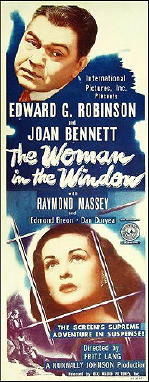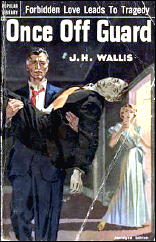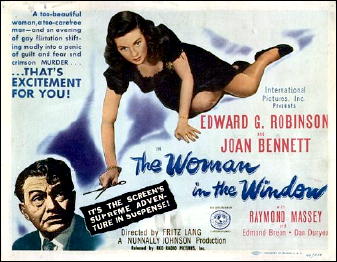Sun 27 Jun 2010
Reviewed by Dan Stumpf: J. H. WALLIS – Once Off Guard / The Woman in the Window (Book & Film).
Posted by Steve under Crime Films , Reviews[4] Comments
J. H. WALLIS – Once Off Guard. E.P. Dutton, hardcover, 1942. Also published as: The Woman in the Window. World, 1944. Paperback reprints: Mercury Mystery #81, 1944, abridged; Armed Forces Edition #723, 1945, as The Woman in the Window; Popular Library #385, 1951, abridged.

I like to do the book/movie thing (read a few chapters in the book each day, then watch the corresponding scenes of the film that night) and got a chance last week with The Woman in the Window, originally published back in 1942 as Once Off Guard by J.H. Wallis and filmed by Fox in ’44.
Wallis’s book is an oddly depressing read, tense and claustrophobic, told almost entirely from the point of view of Professor Richard Wanley, who, overcome by reading erotic poetry of ancient Greece, gets involved with a tart and suddenly has to kill her sugar-daddy in self-defense.
Terrified of scandal and genuinely reluctant to hurt his wife, Wanley and the tart cover up the crime and hide the body, leading to a world of complications.
The book, as I say, gets a bit depressing as Wanley frets and sweats over little things that loom large in his guilty conscience, sure that everyone notices tiny clues that link him to the killing, and it gets worse yet when the tart gets a visit from a prospective blackmailer. All of which leads to more murder, more guilt and a neat, ironic ending. An involving read, but not much fun.

So when Fox took this on for a movie, they gave it to writer Nunnally Johnson, who could be depended on to lighten things up, and director Fritz Lang, whose sense of fatalism was perfectly suited to the material.
The result is just as involving as Wallis’s book, but much less claustrophobic. Characters who seem merely looming presences in the book get neatly fleshed out in the movie by competent players like Raymond Massey, Dan Duryea and Edmund Breon (whom some may remember as the lascivious music box collector in the Sherlock Holmes flick, Dressed to Kill).
Also, we get to see things in the movie that in the book are only imagined by Wanley, opening things out a bit. Finally, there’s a twist ending, followed by a twist on a twist, handled beautifully by Lang in a cinematic flourish where he abruptly changes scenes without cutting.
Think of that: he actually switches scenes without cutting! A friend of mine once asked the director (by then quite aged and revered) how he did this, and Lang merely smiled and said some mysteries were best left as mysteries.
I suspect he just didn’t remember.
Bio-Bibliographical Data: James Harold Wallis, 1885-1958, was the author of ten mystery and crime fiction novels for Dutton between 1931 and 1943, the first six of which were cases for Inspector Wilton Jacks. Says Al Hubin of Wallis in Crime Fiction IV: Born in Iowa, educated at Yale; newspaperman in Iowa turned full-time writer in New York.

June 27th, 2010 at 8:06 pm
I haven’t read the book, though it has long been on my search list. The film is one of Lang’s best from its time period with a touch of black humor we don’t always think of in regard to his work, but which is one of the things Hitchcock picked up working with him in Germany.
This one always reminds me of the film that never was, Lang’s version of the Golem he wanted to do with Robinson co-written by Bertholt Brecht with input from Kurt Weill (THREEPENNY OPERA).
Joan Bennett proved one of Lang’s most enduring heroines, SCARLET STREET, MAN HUNT, THE SECRET BEHIND THE DOOR … she seldom looked better than in Lang’s films.
The ending of this one could easily be a disappointment, but thanks to Lang, Robinson and Massey, and Johnson’s screenplay it is wholly satisfying.
June 27th, 2010 at 8:18 pm
Two of the most commonly found editions of this book are abridged. I wonder why that was, although of course well over half of the Mercury line of paperbacks were cut, simply for space.
Popular Library books less so, but this one is. It’s also the copy I have, which I’ve never read. Perhaps I never made the connection with the movie.
Which I have not seen in over forty years. I remember the opening. Why can’t I remember the ending? Something to look forward to now, it goes without saying.
June 27th, 2010 at 8:27 pm
Like Dan, I love reading the book and then watching the movie version. Then there usually follows a period where I gripe and complain about the movie not being as good as the book. There are exceptions however and this may be one of them.
It’s one of my favorite film noirs and not only because of Lang. I personally think Joan Bennett is a knockout in her films of the forties. She is really amazing in a great film noir named HOLLOW TRIUMPH(The Scar).
June 27th, 2010 at 9:39 pm
Bennett had a rare quality in film noir in that whether she played the femme fatale or the victim you never knew exactly what she was going to do. I’ve always thought she was particularly good in Max Ophuls RECKLESS MOMENT (based on Elizabeth Saxnay Holding’s THE BLANK WALL)as a reluctant murderess blackmailed by James Mason.